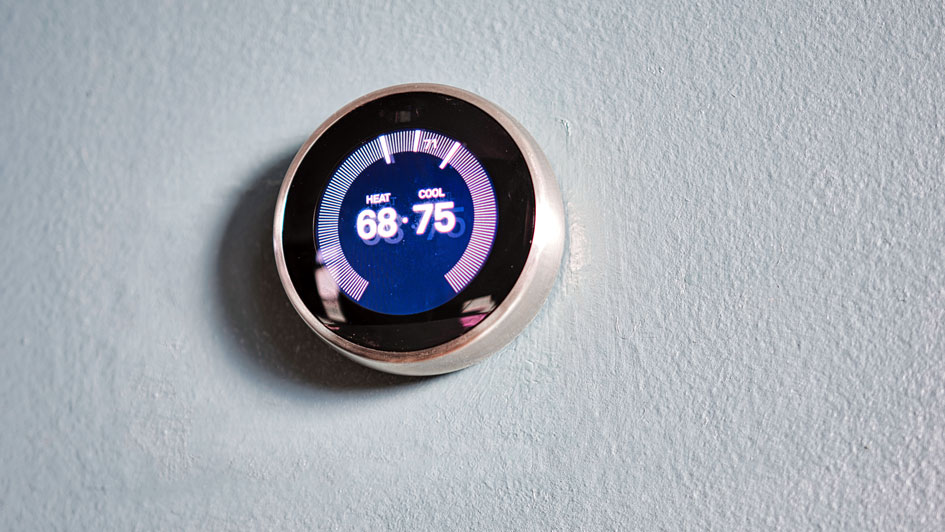
A Nest Thermostat is the perfect way to keep your home comfortable, regardless of the season or weather. With a number of innovative features meant to maximize efficiency, convenience and comfort, a Nest Thermostat is an excellent choice to help you manage your energy use — saving you money in the process.
That’s why more people are looking to add devices like a Nest to their HVAC system. If you want to put in a Nest for your own home, get in touch with an expert for smart thermostat installation in Cambridge.
From automated scheduling to optimizing energy efficiency, Nest makes home climate control effortless.
Want all the details? Here’s a look at 12 things you should know about your Nest Thermostat.
1. Resetting Your Nest Thermostat
One of the first things to know about resetting a Google Nest Thermostat is that there's a difference between a restart and a reset.
- Restart: This process is similar across most electronics, including your phone or computer, restarting your Nest Thermostat means a quick off / on cycle. This preserves current settings and should be attempted if your Nest is frozen or not connecting to Wi-Fi.
- Reset: Conversely, resetting eliminates most if not all of your preferred settings. In most cases, people resort to a reset as they're moving into a new house and bringing the thermostat with them, or if they just want to erase their personal information from the Nest before leaving it for the next homeowner.
If you want to perform a reset, first write down your temperature settings so they're still available if you forget or erase them. Next, locate Settings -> Equipment and record your system wires, heating type and safety temperature settings.
Then, to manually restart or reset your Nest, go to Settings, select Reset and press. You will be presented with five options:
- Restart: Deactivates your Nest and reboots it while saving your settings. You can also press the outside of the Nest and hold it there until it turns black, at which point you can remove your hand.
- Schedule: This reset setting clears any info about your temperature schedule—including for your hot water, if you've connected it to your Nest. By choosing this kind of reset, you’ll be given the chance to plan out a new schedule or wait until the Nest learns your schedule.
- Away: This kind of reset removes anything your Nest has learned about how often you walk by, so that it can update the temperature on its own.
- Network: If you select this reset option, it erases connection info and your Nest can no longer connect to Wi-Fi. It also forgets your Wi-Fi password.
- All Settings: This reset strips away all your personal settings and learning.
2. How to Connect Nest Thermostat to Wi-Fi
A stable internet connection is important if you want the most use of its online features.
To connect your Nest to the internet:
- Turn the thermostat ring to the Quick View menu.
- Select the Settings icon.
- Press Network.
- Once your Nest is finished scanning for local networks, find your Wi-Fi and, if needed, put in your password.
3. Does a Nest Thermostat Have a Battery and How Long Does It Last?
Nest thermostats are powered indirectly through HVAC system, but each one also features a rechargeable lithium-ion battery for backup in case of a power outage. According to Google, Nest's manufacturer, a Nest Thermostat battery should last several months. The Nest's battery is rechargable with a USB cable included with the thermostat.
4. How to Turn Off a Nest Thermostat
If you aren’t going to be in your home for a long time, you can set your Nest Thermostat to Off mode, though Eco mode would be another option. Off mode shuts down all your regular heating and cooling schedules, but it will still adhere to any current Safety Temperatures to keep your home from getting particularly hot or cold.
To select Off mode on the thermostat:
- Hold the touch bar until the display reads “Turn Off” before sliding the bar to highlight Turn Off, and then touch the bar to select.
- You can also go to Mode from the main menu and select Off.
Off mode is available on the Google Home app as well:
- Select Thermostat from home screen
- Tap Temperature mode
- Select Off
5. Is Alexa Compatible with a Nest Thermostat?
Yes, your Amazon Alexa can be used to control a Nest Thermostat. Alexa voice controls are also available with Nest doorbells and cameras. And of course, you can use Google Assistant to control your Nest.
6. Will My Nest Thermostat Work Without Wi-Fi?
Yes, your Nest Thermostat can control the temperature of your home without Wi-Fi. However, a lack of an internet connection means your Nest doesn’t have access to all the key features that most people enjoy.
7. Are You Able to Lock a Nest Thermostat?
If you’re having a battle over the thermostat in your home between people who like things hot and others who prefer them cold, Nest offers a handy feature that keeps things simple.
A user can 'lock' the Nest to stop any temperature adjustments outside of a preset range. This doesn’t lock in a specific temperature—a locked Nest will still continue to run the programmed settings—but simply prevents people from changing the settings.
To lock a Nest:
- Press the Settings icon, scroll to the bottom and tap on Lock.
- Enter a 4-digit pin number you can remember, and do so twice.
- To lock your Nest in Heat or Cool mode, define your maximum and minimum temperature range and then tap Lock at the bottom of the screen.
When you're ready to unlock the Nest, open the settings and choose Unlock. After you've entered the 4-digit pin, your device will be unlocked.
8. Adjusting a Nest Thermostat from Your Phone
Nest thermostats can be controlled by your Google Home app, accessible through your phone as well as a computer. Other versions of Nest, including the Nest Thermostat E and Nest Learning Thermostat, are also compatible with remote control via the Nest app.
Before you can control a Nest on your phone with Google Home or the Nest app, there are a few steps to complete first:
- Download the Google Home app or, if you have an advanced model, the Nest app to your phone.
- Hook up your Nest Thermostat.
- Open the Google Home app on your phone and complete the setup process, link to your new device and connect to Wi-Fi.
- Google has created a more comprehensive setup guide, if you would like more assistance in connecting.
As soon as you've connected the Nest to your Home app, you can access it by clicking Thermostat on the home screen. Once you do that, you can make changes to the temperature by dragging your finger along the screen or tapping on a plus or minus sign.
You also can change preset Nest temperatures on the app. From the home screen, select Thermostat and then select Settings. Once there, select Temperature Preferences and then Temperature Presets. This will display your preset Comfort, Eco and Sleep temperatures. Choose the appropriate setting to change the temperature for that preset.
9. Creating a Nest Thermostat Schedule
A Nest allows you to set temperatures schedules either on the device or on the Google Home app. Newer and advanced models of the Nest, such as the Nest Thermostat E and Nest Learning Thermostat, can also be adjusted by using the Nest app.
There are two ways you can set up a schedule on your Nest:
- Quick Schedule: Quick Schedules are based on the national average schedule for energy efficiency. As you set the thermostat up, the Google Home app allows you to change the temperature with a schedule. When choosing this option, it presents a preset schedule for you to customize as you wish. Once setup is complete, that’s the schedule it will use.
- Temperature Presets: If you prefer other basic preset options, open the Google Home app and press Thermostat. Then, tap Presets and choose Edit. As soon as you're finished making updates, select Done.
To make tweaks or changes to your current schedule, open the Google Home app, select Thermostat and then tap on Schedules. You can then pick the day of the week that you want to add a temperature. After the day is selected, tap Add and select the preset you want. Finally, select Time before touching and dragging the numbers to change the time. The changes won't save unless you select Done.
10. How to Set a Temperature Range on a Nest Thermostat
You can set a temperature range on a Nest Thermostat in the Eco mode. A key part of this feature is the Nest's ability to adjust the temperature based on whether it detects you at home or not.
To access Eco mode for customized temperature ranges, go to Settings and select Eco. That should display the current “Heat to” and “Cool to” temperature settings. You can select each and adjust them to your desired temperature. When complete, select Done.
11. What Should I Do If My Nest Thermostat Isn't Compatible?
Nest thermostats can be integrated with most heating and cooling systems. The maker of Nest, Google, has an online compatibility checker that presents a few questions related to your location and existing setup to see which Nest model works with your system.
If you have a Nest and believe it’s not compatible with your system, it’s best to reach out to a professional for smart thermostat installation in Cambridge. Technicians with the proper experience can assess your system and, if your Nest is compatible, get it installed and on the road to saving you money in no time.
12. Can I Manually Control My Nest Thermostat?
Nest Thermostats come with many features designed to increase comfort and decrease costs. However, you have the ability to turn off the smart features if you prefer to control your Nest like it's a normal thermostat.
Bear in mind, by doing this you're eliminating your temperature schedules and your Nest will work like any other thermostat—it will display the temperature and allow changes, but that’s about it.
Setting your thermostat to manual controls can be accomplished with the following steps:
- Auto-Schedule: From the main screen, go to Settings and then scroll to Nest Sense. Go to Auto-Schedule, select No and click Done.
- Eco: From the main screen, go to Settings, scroll to Eco. Once in Eco, select Off for both the current Heat to and Cool to temperatures, and select Done.
- Home/Away Assist: From the main screen, go to Settings and select Home/Away Assist. Then, select Stop Using and click Done.
- Reset: After you've cleared the settings, reset your nest. From the main screen, go to Settings and select Reset, highlight Schedule and then select Reset to clear out any saved scheduling data.
